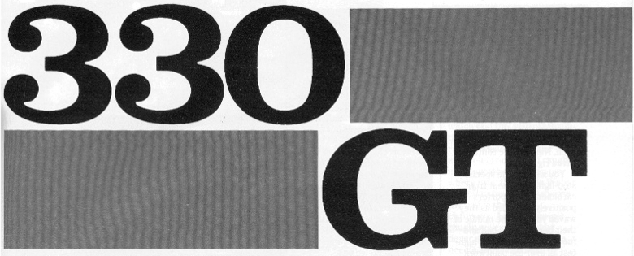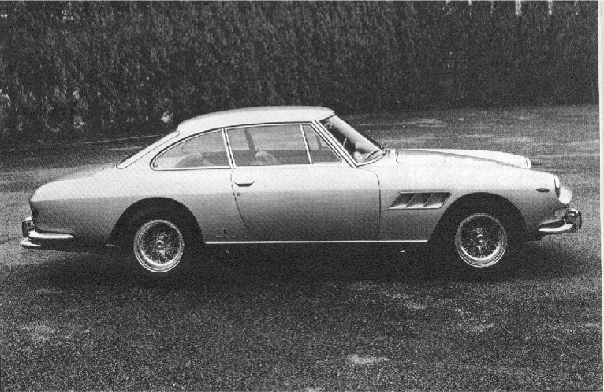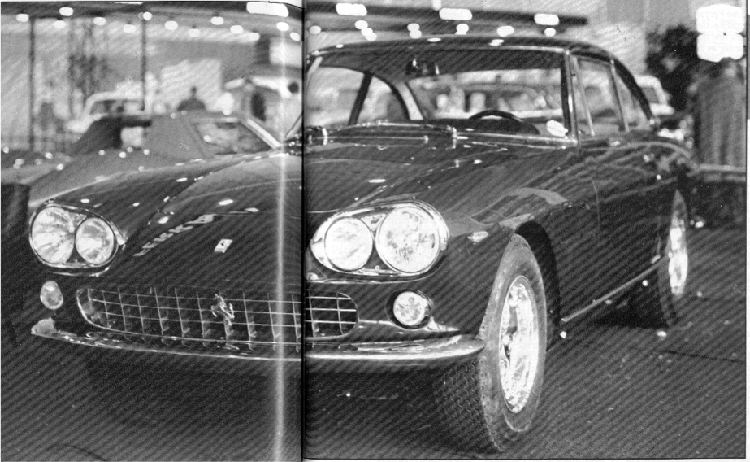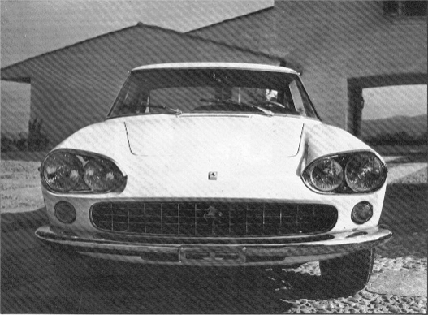 | 330 GT Registry |  |

When Sloniger tested this Ferrari in 1966 road tests cars were non existent — so he sought the aid of a friend.

Let's tell the basic truth here: how many times have you held up a line of ravening rush-hour traffic to ask a cop for directions and gotten not only a fulsome answer but an avuncular pat on the arm as well? Correct, and my score was about the same until I tried the trick in a Ferrari 330 GT Coupe Pininfarina 2 + 2 (to get all the status in at once). After that event my score stood at roughly one to one million and was very unlikely to improve.
Ferrari test cars were at the time non-existent by all normal standards since the good Commendatore had a very low opinion of the motoring press (he might have a point) and a long waiting list for his expensive toys. Why spend time replacing clutches fiended by journalists when you could just as easily use it to rack up another million lire?
Fortunately, a friend got his second-hands on a very late model 330 and by plying him with ancestral brandy I got into the driver’s seat.
So what’s all the fuss? After all, the car only cost $10,500 at the factory, hardly more than 10 or 11 Volkswagens, for instance. In theory: of course they had a very high price for chrome-plated pasta in Maranello and it wasn’t considered fair Ferrari play to quibble over the bill. Besides, it could be a real saving. Take parking: instead of 11 stalls for all those beetles you could park the 330 in the space of two such. Nine garage rentals saved right off.
You also got the special stop-light treatment from carbinieri, hotel porters positively grovelled as they waved you into the middle of their best begonia bed and fuel attendants poured high-test all over the paintwork while trying to read your Pininfarina badge just forward of the wheel arches.
Of course, it cost a packet just to say “ciao” to the manager and they had to fly a man in from Modena if you wanted the air cleaner lifted to examine the carburettors.
Admitting, then, that the car was lousy with status and actually a saving to run, what else did it do? Well, you could seat four if all were Italians and the driver wore size four shoes. And wives seldom complained about the rear bins for at least 30 km, they were so intrigued with the Ferrari mystique. That was worth the price alone.
Furthermore, the car would actually creep along on idle in town, in second or third, so you seldom had to use the clutch at blind corners. This was a basic fact of Ferrari driving. They quit using Fiat 1100 clutch plates but it was still considered ham-fisted (-footed?) to declutch more than once an hour, as well as expensive. Point is, with all 4-litre elasticity you didn’t have to; just learnt a new way of driving.

As a matter of fact, the 330 we tried would surge sweetly from 1000 to 6600 in fifth gear, which was a span of perhaps 55-240 km/h, a pretty good parley in any language. It didn’t take quietly to snap shifts via that notched and reluctant knob, but you didn’t really need to bang it through. Third gear synchro was off (second box in 13000 km, but if you asked the price you couldn’t afford a Ferrari) but this was quickly mastered.
Ferrari claimed — and we accepted in deference to our friend’s clutch — that the car go to 97 km/h in around eight seconds and to 200 in 27, give or take a few tenths. It may not have been the drag- strip record, but you were moving nearly 1.79 tonnes two-up and fueled and, anyway, 200 was top in four, with another whole (over drive) gear to go. They claimed 240 in top but I backed down at about 220 no guts. My story is that the roads were crowded, though the left lane cleared magically at a toot of the air horn and a rear-mirror glimpse of that snout bearing down.
 Speaking of the snout, there were those — me, for instance who didn’t think Pininfarina hit his styling peak with that headlamp treatment, but you could always take it to a California hot-rodder for a chop and channel job. From any other angle the proportions were so good you didn’t realise what a van this really was. Finish was good, despite the awful maroon shade, the leather seats and floor carpets felt luxurious and they even got a boot in.
Speaking of the snout, there were those — me, for instance who didn’t think Pininfarina hit his styling peak with that headlamp treatment, but you could always take it to a California hot-rodder for a chop and channel job. From any other angle the proportions were so good you didn’t realise what a van this really was. Finish was good, despite the awful maroon shade, the leather seats and floor carpets felt luxurious and they even got a boot in.
This may not have surprised normal mortals but old Ferrari hands appreciated the revolution. You could actually store a couple of good-size cases and three or four soft ones in the boot, along with the spare, a far cry from when you tied down one small case behind the seat, next to the extra wheel.
Getting specific, there was nearly 4,88 cm of length there, mostly given to Colombo’s beautiful V12, on an 2.67 cm wheelbase but only 12 cm of road clearance— there went our creek-fording test shot.
From the driver’s seat you saw considerable bonnet, but the corners were entirely visible — right where some taxi was about to make expensive gouges. That was really why it seemed big at rest. The price tag. That and the fact that the seats were low, but the scuttle relatively high, for an average frame.
As for driving position, Enzo is a big man and I’m damned if I know how he managed. Ignoring legless howls from the back, you could shove the driver’s seat right back and have excellent leg position — except that it took a gorilla with lazy, long arms to reach the smallish wheel. With the steering within your grasp (which at least suited the back passengers better) you sat there looking like an order of frog-legs-akimbo. Coupled with the smallest possible area for your shoes, this lead to braking with the outside edge of the right foot. What’s more lifting a size nine off the gas suddenly became a game. It could very well stick under the brake and leave you flat out at an indelicate moment.
Fortunately, when you did get on the brakes there was action of a first-rate kind. It only seemed like you needed all day to stop — mostly because the car did 190 so effortlessly that you forgot about the laws of inertia.
Fortunately, the steering, while heavy, was quick, which could be disconcerting at first but a comfort for sudden dodges. Despite its bulk, the Ferrari seemed to know where you wanted to go before you did, and went without drama, though long acquaintanceship led to pretty heavy shoulder muscles.
In all fairness, the car, which started life as John Surtees’ private transport, was shod by him with Dunlop R6 green spots, hardly the ideal solution for parking speed manoeuvres. They also had a disconcerting tendency to treat white lines on the pavement like tram tracks but it never jumped more than a foot sideways at any one time. This rubber was mounted on one-off alloy spoke wheels which were something of a scoop since there was at least a 50-50 chance they would become ‘assembly-line’ wear for other Ferraris one day.
Getting back to the cockpit, the proper drill, laid down in a 106-page tri-lingual owner’s manual, was to punch the tumbler marked ‘A’ and listen to the tick which said fuel was reaching the Webers. They also recommended using the extra electric pump if caught in hot-weather traffic jams where your three twin Weber 40 DFI carbs might vaporize the fuel in their float chambers. Actually, we got caught several times and never saw the temperature needle anywhere near danger, thanks to an electromagnetic cut-in fan which worked.
Anyway, you were told flatly to give it two minutes of warm-up in summer and three in winter at a steady 2000, which made it hard to sneak off soundlessly at three in the morning. Then you trickled away, but not by slipping the clutch, until it got to about 2000 when you stepped down hard. From there on it was all go in a very refined manner.
The real reason they got the price was that unmistakable Ferrari noise. There was a fortune to be made with tapes played in Fiats.
Further gleanings from the manual included the admonition to have the car washed only by specialists — more round trip tickets from Modena — and to change the plugs every 6000 miles, hell or high water. I hardly managed to keep it that long, but had absolutely no trouble with oiling in traffic.
When you came right down to it, Ferraris sold in 1966 despite a 14 m turning circle, awkward driving position, wind roar and expense of repairs for the simple reason that they were individualists in a conformist world. It wasn’t just that you weren’t likely to have more than one on your block; more it was the fact that nothing I said here applied to any Ferrari but this one. As Sergio Pininfarina pointed out, it was like taking on a mistress — you expected action, not perfection.
Ferrari No. 1 - A WHEELS and SPORTS CAR WORLD publication